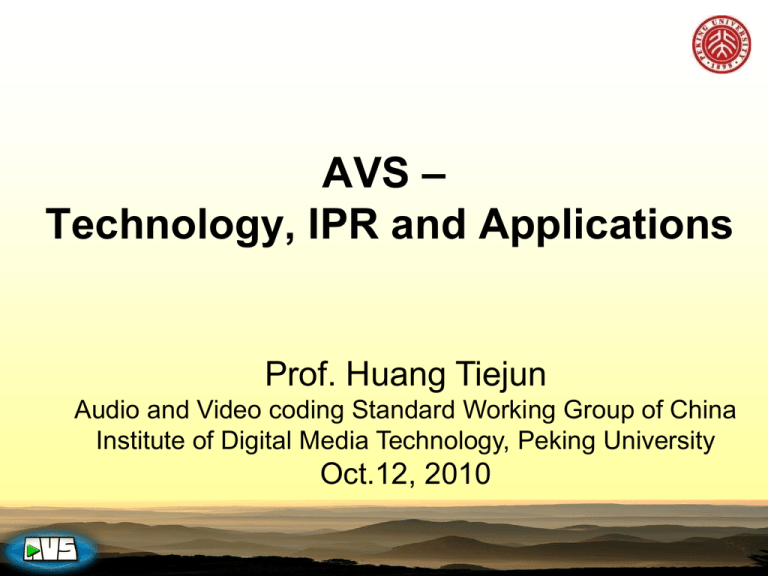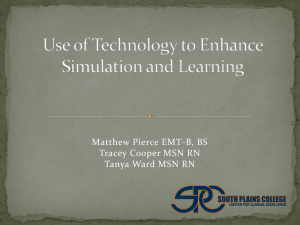AVS Standards - 数字音视频编解码技术标准工作组
advertisement

AVS –
Technology, IPR and Applications
Prof. Huang Tiejun
Audio and Video coding Standard Working Group of China
Institute of Digital Media Technology, Peking University
Oct.12, 2010
Video coding…
• Compress high bit-rate digital video signal
as low bit-rate stream
– SD: from ~250Mbps to < 5Mbps
– HD: for >1Gbps to < 20Mbps
• is the reason makes DTV possible at 1994
• and always a core concern for Digital TV
system and any other digital video
applications
Video coding Standards
• ISO/IEC recommended MPEG series standards
– MPEG-1, MPEG-2, MPEG-4
• ITU-T recommended H.26X series standards
– H.261, H.262, H.263, H.263+, H.263++
1G standards
2G standards
H.264 /
MPEG-4 AVC
China
MPEG-China
AVS
3
MPEG-2: the 1st Generation
• ISO/IEC 13818 / ITU-T H.262 @ 1994
– SDTV at ~5Mbps
– HDTV at ~20Mbps
• Makes DTV became reality
– Europe DVB at 1997
– USA ATSC at 1997
– Japan ISDB at 1998
– China DTMB at 2006
AVS – one of the 2nd Generation
• In Feb2006, AVS video
issued as Chinese national
standard
– GB/T 20090.2-2006
– Effective from Mar2006
• In Aug2006, DTMB issued
as Chinese national
standard
– GB/T 20600-2006
– Mandatory from Aug2007
5
5
2ndG Video – ITU-T IPTV Selection
• ITU-T IPTV FG decided to
recommended the following video
format at May2007
–
–
–
–
H.264/ MPEG-4 AVC
MPEG-2 (for Legacy)
AVS – GB/T 20090.2
SMPTE VC-1
• ITU-T Q6-WP3-SG16 meeting
at last week (10July09) decided
to release upper document as
the ITU Technical Paper on
“Media coding toolbox for IPTV”
2015/4/9
6
Video Compression Performance
Improvement
Compression Ratio
AVS-?/MPEG-?/others-?
250
HD: 6-8Mbps
SD:1-2.5Mbps
150
AVS
MPEG-4 AVC/H.264
VC-1
HD: 20 Mbps
SD:4-6Mbps
MPEG-2
50
MPEG-1
19911994
2003
2030
7
Outline
•
•
•
•
•
•
Licensing problem for AV standards
AVS approach for dealing with IPR
AVS Video technologies
AVS Products
AVS Applications nowadays
Conclusion and Discussion
Higher Performance, High Cost
• Gold age is far away…
– MPEG-1,MPEG-2
– H.261,H.262, H.263,H.263+/++
• Face to complicated situation nowadays
– H.264,VC-1
MPEG Standards
• 1991:MPEG-1
– Royalty Free
• 1994:MPEG-2
– DVD, DTV, Emmy Award
– 2.5$ per device
• 1996:MPEG LA—A licensing agency
• 1999:MPEG-4 SP (Part 2)
– 0.25 $/device, coding time based charge (2 cents/ hours)
– Objected by AOL-Times Warner
• 2003:H.264/MPEG-4 Part 10 AVC
– Nov. 17,2003: Licensing policy – title based licensing
– Objected by EBU(EBU Technical Statement-D 96-2003)
– May.20,2004: Policy finalized, little revision
10
First Effort to deal with patent issue for
MPEG-2
•
•
•
•
•
Leonardo Chiariglione《Patents and standards》
– http://www.chiariglione.org/ride/patents_and_standards.htm
If Gutenberg had lived in a culturally more advanced city like Venice or Florence,
which had already started issuing litterae patentes ("open letters", whence the word
"patent" comes from) since a few decades, he could have protected his invention with
a patent.
Some time later, MPEG had to deal with MPEG-2 patents. Many companies had
participated in the MPEG-1 development not so much because they necessarily had
plans to make products in that space, but because they were keen to be around and
help tune up the MPEG machine for the big MPEG-2 deal.
In January 1993 I took the initiative to invite to the Rome meeting Mike
Smith, head of the Information Technology Task Force (ITTF), the group
inside the ISO Central Secretariat in Geneva looking after JTC1 matters.
Mike provided advice on how this difficult issue could be treated without
trespassing the limits set by the ISO/IEC directives.
In the event, an MPEG-2 Patent Pool was established, managed by MPEG
LA. This organisation acts as a "one-stop shop" for MPEG-2 Video and
Systems patents (Audio is not part of the licensing), but there are a few
companies licensing their technology separately.
The result is reasonable
(4$ - 2.5$/device)
网址 http://www.mpegla.com
AVC/H.264 licensing structure
Participation Fees
Where End User pays
Subscription
Codec
Manufacturers
Title-by-Title
Internet
Broadcast
Free
Television
Participation Fees where
Remuneration is from
Other sources
Source:AVC/H.264 license terms
2015/4/9
http://www.avs.org.cn
13
AVC/H.264 License Terms:
Participation Fees
•
Where End User pays for AVC Video
– Subscription (not limited by title) – 100,000 or fewer subscribers/yr = no
royalty; > 100,000 to 250,000 subscribers/yr = $25,000; >250,000 to
500,000 subscribers/yr = $50,000; >500,000 to 1M subscribers/yr =
$75,000; >1M subscribers/yr = $100,000
– Title-by-Title - 12 minutes or less = no royalty; >12 minutes in length =
lower of (a) 2% or (b) $0.02 per title.
•
Where remuneration is from other sources
– Free Internet Broadcast (not title-by-title, not subscription) – no royalty
during first term (through 2010; not greater than free television thereafter)
– Free Television - (a) one-time $2,500 per transmission encoder or (b)
annual fee starting at $2,500 for > 100,000 HH rising to maximum $10,000
for > 1,000,000 HH
• Enterprise cap: $3.5M/yr 2006-07, $4.25M/yr 2008-09, $5M/yr 2010
• Royalties begin January 1, 2006
Source:AVC/H.264 license terms
2015/4/9
http://www.avs.org.cn
14
Effort for 2G: RF JVT baseline
AVS Strategy turned in 2003
For JVT baseline + essential enhanced tools
To a dependent, compact, patent clear standard
MPEG LA专利池构成与风险分析
AVS Mission
• To develop a 2nd Generation video coding
standard with same/better coding performance
than others
• Avoids licensing risk based on clearly analysis of
related patents in last 50 years
• To help DTV, IPTV and new media operators in
China and out of China leave from more and
more dangerous licensing mire
• AVS was born at Mar.2002
2015/4/9
18
Outline
•
•
•
•
•
•
Licensing problem for AV standards
AVS approach for dealing with IPR
AVS Video technologies
AVS Products
AVS Applications nowadays
Conclusion and Discussion
AVS Working Group
• Set up by MII (Ministry of Information
Industry) in June of 2002
• In charge of national standardization of
audio-video coding for Chinese A/V
industry
• Also in charge of organizing the delegation
of China National Body to MPEG(ISO/IEC
JTC1/SC29/WG11)
2015/4/9
AVS membership
180
160
140
120
Total
New
End
100
80
60
40
20
0
2015/4/9
2002 2003 2004 2005 2006 2007
国内企业 Local Members
2015/4/9
MNC or Out of China
外资企业和国外企业
2015/4/9
AVS Subgroups
•
•
•
•
•
•
•
•
System
Video
Audio
Digital Media Rights Management
Requirement
Conformance
IPR
Implementation
2015/4/9
AVS IPR Experts Group formation
• Late 2003 the President of AVS asked that a group of
experts be assembled to create a recommendation for
an IPR policy for AVS
• Create policies that:
–
–
–
–
–
–
2015/4/9
reflect and respect China law and culture
reflect WTO requirements
reflect successful global practices
balance the rights of the inventor and needs of the implementers
innovative and forward looking
evolves with practice and law in China
Mission of AVS IPR Group
• Make a friendly environment for technical
society (standard body), industry, and end
user
• Key issue to work out
– Reforming the IPR policy making by only IP
holder, to by IP holder + industry + consumer
2015/4/9
AVS IPR Experts Group
• Experienced members:经验丰富的成员
–
–
–
–
Patent Attorneys专利律师
Technical Experts技术专家
Contract Attorneys处理合同的律师
Previous experience in setting up patent pools具有建立专利池相关经
验的成员
• Members are from:成员来自
– Asia 亚洲
– Europe 欧洲
– North America 北美
• Members represent: 成员代表了
– Consumer Electronics 消费电子产品界
– Information Technology 信息技术界
– Microelectronics微电子产业界
2015/4/9
AVS IPR Experts group
• Members
–
–
–
–
–
–
–
–
2015/4/9
Broadcom
IBM
Intel
Matsushita/Panasonic
Microsoft
Nokia
Sony
Sun Microsystems
Licensing Obligations
Join AVS
• Sign Member Agreement
•Declare default option
2015/4/9
Non-Participant:
• RAND RF
• POOL
• RAND
• No License
Participate in Subgroup
• Commit to license
• License options
• RAND RF
• POOL
• RAND
Submit Contribution
• Disclose patents
•Declare license option
China Patent:
• RAND RF
• POOL
Participant:
• RAND RF
• POOL
• RAND
Worldwide Patent:
• RAND RF
• POOL
• RAND
Disclosure Obligations
• When making a contribution
– Unpublished, published and granted patents
• Ongoing
– When a patent is discovered
– When a Patent Application is published
• During Final Draft Standard Review
– 90 days to declare licensing option, OR:
– Default applies
2015/4/9
http://www.avs.org.cn
31
AVS Licensing
• 1 RMB concept
– Only one charge, to device/software/chip
– No charge to operator
– No charge to end-user
• Will be handled by AVS PPA
– PPA is a non-profit organization
– Founded By #1 institute of MII and ICT of
CAS, in 2005
2015/4/9
http://www.avs.org.cn
32
Three Independent Organizations of AVS
AVS
Working Group
Technical Evaluation
Licensing principle
IPR
Principle
AVS
Patent Pool Council
AVS Licensing
Essential
evaluation
One-Stop
license
AVS
Industry Alliance
Cooperation &
Development
Applicatio
Standard
Better
Implem.
•AVS Industry Chain
Public
knowledge
AVS
Patent:
Stand
ards
-Royalty
Free
-AVS Pool
-RAND
2015/4/9
R&D
AVS
Patent Pool
IPR
•ICs,software
•Device,System
•Operating,Service
•AVS Industry Cluster
•HDTV
•IPTV
•DTH
•MobileTV
•……
Industry
33
AVS Industry Alliance
–
–
–
–
–
–
–
–
2015/4/9
Amoisonic
Broadcom
Changhong
Haier
Huaju
Huawei
Langchao
NSCC
–
–
–
–
–
–
–
–
http://www.avs.org.cn
Panstar Semi
SVA
Skyworth
Spectrum
Communication
Sunnywell
TCL
USstarcom
ZTE
34
Outline
•
•
•
•
•
•
Licensing problem for AV standards
AVS approach for dealing with IPR
AVS Video technologies
AVS Products
AVS Applications nowadays
Conclusion and Discussion
AVS1 Family
AVS Parts
国家标准计划号
STD Number
小组草案
(WD)
工作组
最终草
草案(CD) 案(FCD)
标准送审
稿(FD)
AVS1-P1(系统-广播)
20051304-T-339
2003.10
2003.12
2006.10
2007.03
AVS1-P2(J-profile)
20032265-T-339
2003.10
2003.12
2004.4
2004.8
AVS1-P2(X-profile)
20032265-T-339
2005.9
2006.3
2007.12
AVS1-P2(S-profile)
20051305-T-339
2007.12
2008.3
2008.6
2008.9
AVS1-P3 (Audio-Stereo)
20051305-T-339
2004.12
2005.3
2005.12
2006.4
AVS1-P3(M-profile)
20051305-T-339
2005.9
2005.12
2005.12
2006.4
AVS1-P4(Conformance)
20051306-T-339
2006.9
1006.12
2007.3
AVS1-P5(Ref. Software)
20051307-T-339
AVS1-P6(DRM)
20051308-T-339
2005.3
2005.12
2006.12
2007.3
AVS1-P7(Mobility Video)
20051309-T-339
2004.6
2004.9
2004.12
2006.4
AVS1-P8.1(System-IP)
20074554-T469
2005.3
2005.9
2005.12
2006.3
AVS1-P8.2(System-IP)
20074554-T469
2006.1
2006.3
2007.6
AVS1-P9.1(File Format)
20074555-T-469
2005.3
2005.9
2005.12
2007.12
AVS1-P9.2(File Format)
20074555-T-469
2006.1
2006.3
2007.9
2007.12
AVS1-P10(Mobile
Speech
2015/4/9
and Audio)
TBD
2007.3
2007.11
2008.3
2007.6
国家标准发布
实施(GB)
2006.2
MPEG-2 Video
Control
Control Data
Trans./
Quant
-
Coeff.
IQ/IT
Decoder
Entropy
Coding
0
Motion
compensation
Inter/Intra
MV
AVS Tutorial
Motion
estimation Oct.20, 2004
37
AVS Video
Control
Control Data
Trans./
Quant
-
Coeff.
IQ/IT
Decoder
Entropy
Coding
Intraframe
Prediction
Deblock
Motion
compensation
Inter/Intra
MV
AVS Tutorial
Motion
estimation Oct.20, 2004
38
AVS Video
Control
Control Data
Trans./
Quant
-
Coeff.
IQ/IT
Decoder
Entropy
Coding
Intraframe
Prediction
Deblock
Motion
compensation
Inter/Intra
MV
AVS Tutorial
Motion
estimation Oct.20, 2004
39
Periods of key video coding tools
contributed
DPCM
Macroblocks
Transform
Coding
P-frames
B-frames
DCT
1950
Huffman
Coding
Video
Object
Planes
Variable Blocksize Motion
Compensation
Multiple
Reference
~1988
Hybrid
Coding
Block
Motion
Estimation
Scene
Adaptive
Coder
Interlace
Motion
Vector
Prediction
ObjectBased
Scalabilit
y
1999
Generic
B-pictures
Integer
Transfor
m
Advanced
Deblockin
g Filter
Error
Resilienc
e
Modified from C Reader,
2002
2015/4/9
http://www.avs.org.cn
40
Coding tools and its contribution
Entropy coding
ME and MC
Transform and bit allocation
Color space Conversion
1st G
2
*
3
*
3
*
3
≈
50
2nd G
2
*
3
*
6
*
3
≈
100
2015/4/9
41
AVS Video Tools
•
AVS1 video accepted 42 technical proposals from more than 200.
•
Major tools
–
–
–
–
–
–
–
•
Transform – 16bit-implemented 8x8 integer transform
Quantization and scaling - scaling only in encoder
Intra prediction – 5 modes
Motion compensation – 16x16/16x8/8x16/8x8 modes
Quarter-pel interpolation – 4-taps interpolation filter
Deblocking
Entropy coding
Minor tools
– Motion vector prediction
– Skipped mode and Coded block pattern
– Adaptive scan
AVS Tutorial
Oct.20, 2004
42
Spatial Coding Tools
1970s
1960s
Andrews, 1968
Fourier
Transform
Huang 1966
Statistical
Coding
Max, 1960
Non-Uniform
Quantizer
Fano 1949
Huffman 1952
Pratt, 1969
Hadamard
Transform
Chen, 1973
Slant
Transform
Ahmed, 1974
Cosine
Transform
Pratt 1969
Zonal
Coding
Habibi, 1971
Block
Classification
Huang 1963
Block
Quantization
Tasto 1971
Adaptive
Block
Coding
Seyler 1962
VariableLength Coding
VLC
Chen 1981
Scene
Adaptive
Coder
VLC Video
Woods 1969
Dead-Zone
Quantizer
Uniform
Quantizer
Pratt 1969
Threshold
Coding
Tescher, 1976
Pratt, 1970
Run-Length
Coding
Tescher, 1975
ZZ-RunLength
Coding
Zigzag Scan
Tescher, 1977
C Reader, 2002
2015/4/9
Rate Buffer
43
173 184 190 198 194 192 192 192
Y
RGB
180 187 182 189 193 191 194 196
180 180 181 182 184 189 196 199
178 174 174 175 180 186 175 177
U
173 167 170 176 178 181 179 177
V
YUV
DCT
170 171 176 184 185 175 172 181
165 167 165 168 174 171 175 181
162 163 163 158 162 169 172 175
VLC/
CABAC
179
-2
0
0
0
0
0
0
4
0
0
0
0
0
0
0
64
0
0
0
0
0
0
0
0
0
0
-1
0
0
0
0
0
1430 -32
0
0
0
0
0
00 .587
0.114Quant
Y -1 00.299
R 0
0 0 0 0 0 0 0 0
U
0
.
169
0
.
332
0
.
500
0 0 0 0 0 0 0 0
G 128
0
0
0
0
0
V 0 00.500
00 .419
0.0813 B 128
-4
-1
4
-4
0
-2
-2
-9
-4
-1
0
-3
-3
0
-7
3
-6
-6
0
-4
0
7
3
-16 -3
5
1
-2
-1
-12
8
-8
-2
-1
-1
4
-1
-3
0
0
2
-2
0
2
0
3
-4
2
0
-4
6
3
0
5
-4
-1 -10 4
-1
-3
2
011010001011101...
7
7
8 8 16 1619 1922 2226 2627 2729 2934 34 16 16 11 11 10 10 16 16 24 24 40 40 51 51 61 61
16 16 16 16 16 16 16 16 16 16 16 16 16 16 16 16
C(h,v)=C(v)C(h)ΣΣ[P(x,y)COS{πv(2y+1)/16}COS{πh(2x+1)/16}]
17 17 18 18 24 24 47 47 99 99 99 99 99 99 99 99
18 18 21 21 26 26 66 66 99 99 99 99 99 99 99 99
16 16x=0
16 16 16 16 16 16 16 16 16 16 16 16 16 16
y=0
16 1616 1622 2224 2427 2729 2934 3437 37
12 12 12 12 14 14 19 19 26 26 58 58 60 60 55 55
24 24 26 26 56 56 99 99 99 99 99 99 99 99 99 99
16 16 16 16 16 16 16 16 16 16 16 16 16 16 16 16
19 1922 2226 2627 2729 2934 3434 3438 38
14 14 13 13 16 16 24 24 40 40 57 57 69 69 56 56
22 2222 2226 2627 2729 2934 3437 3740 40
16 16 16 16 16 16 16 16 16 16 16 16 16 16 16 16
C(0)=1/2√2
C(v)=C(h)=1/2
[v,h≠0]
16 16 16 16 16 16 16 16
22 2226 2627 2729 2932 3235 3540 4048 48
99 99 99 99 99 99 99 99 99 99 99 99 99 99 99 99
47 47 66 66 99 99 99 99 99 99 99 99 99 99 99 99
16
16
16
16
16
16
16
16
14 14 17 17 22 22 29 29 51 51 87 87 80 80 62 62
18 18 22 22 37 37 56 56 68 6810910910310377 77
99 99 99 99 99 99 99 99 99 99 99 99 99 99 99 99
16 16 16 16 16 16 16 16 16 16 16 16 16 16 16 16
26 2627 2729 2932 3235 3540 4048 4858 58
24 24 35 35 55 55 64 64 81 8110410411311392 92
99 99 99 99 99 99 99 99 99 99 99 99 99 99 99 99
16 16 16 16 16 16 16 16 16 16 16 16 16 16 16 16
26 2627 2729 2934 3438 3846 4656 5669 69
49 49 64 64 78 78 87 87103103121121120120101101
99 99 99 99 99 99 99 99 99 99 99 99 99 99 99 99
16 16 16 16 16 16 16 16 16 16 16 16 16 16 16 16
27 2729 2935 3538 3846 4656 5669 6983 83
72 72 92 92 95 95 98 9811211210010010310399 99
DCT-based Compression
AVS Innovation Example(1)
DCT Transform Matrix in AVS
Differs from the one in MPEG-2 (floating value) and
H.264 (4X4 and 8X8) that was patented
with similar performance (or even better in some cases )
2015/4/9
45
Temporal Coding Tools
1960s
1970s
Seyler 1962
Temporal
Statistics
PRA Motion
Estimation
Candy 1971
Conditional
Update
(Spatial; Pixel)
DPCM
Netravali 1979
Motion
Measurement
Motion
Modeling
Seyler 1962
Harrison 1952
Limb 1975
Brofferio 1970
Netravali 1979
Motion
Compensated
DPCM (Pixel)
3D
(Temporal)
DPCM
Rocca 1969
Conditional
Update
(Spatial; Block)
Taki 1974
BMA
Motion
Estimation
Motion
Compensated
DPCM (Block)
Giorda 1975
Variable –
Size BMA
Motion Est.
Jain 1979
Schroeder 1970
Transform in
DPCM Loop
with MC
Hybrid
Coding
Pratt 1968
Transform
Coding
(Intra)
H.120
Koga 1981
Reader 1973
Conditional
Update
(Transform)
Roese 1975
H.261
MPEG1
MPEG2
Etc.
Netravali 1979
Motion
Compensated
Transform
Hybrid
Coding
(Transform)
Jones 1978
C Reader, 2002
Interlaced
Field/Frame
Coding
MPEG2
46
Skip, Direct and Symmetry
Modes in B-frame
• Same:
– Use both forward and backward
reference frame to predict
• Different:
MV forward
Time t-1
Time t
MV backward
Time t+1
– Skip: no coded MVD, no coded
coefficient
– Direct: no coded MVD, with
coded coefficient
– Symmetry: with 1 coded MVD
and coded coefficient
47
AVS B-frame Compared with Other
Standards
• Other Standards
• AVS
– Bi-prediction
– Bi-prediction
• Skip, direct
• Skip, direct
– No motion vector
• Other cases
– 2 coded motion
vector
– No motion vector
• Symmetric
– 1 coded motion
vector
• Higher
compression ratio
48
AVS vs. H.264 vs. MPEG-2
tools
AVS1-P2
H.264
MPEG-2
Intrainterpolation
8x8, 5 modes for Y
prediction, 4 modes
for UV prediction
4x4, 9 modes for Y
prediction, 4 modes
for UV prediction
Prediction only
to DC coefficient
Reference
frame
<=2
<=16
<=2
Block-size for
MC
16x16, 16x8, 8x16
8x8
16x16, 16x8, 8x16
8x8,8x4,4x8,4x4
16x16,
16x8(interlace)
B frame
micro-block
bi-direction
prediction
Coding front motion
vector, and
computing back
motion vector
Coding two motion
vectors
Coding two
motion vectors
AVS vs. H.264 vs. MPEG-2 (cont’d)
tools
AVS1-P2
H.264
½ pixels 6-tap
¼ pixels 2-tap
MPEG-2
¼ pixel MC
½ pixels 4-tap
¼ pixels 4-tap
Transform
and
quantizatio
n
8x8 integer transform, 4x4 integer transform, 8x8 float DCT
encoding site
both encoding and
normalization only
decoding sites need
to normalize
Entropy
coding
Adaptive 2D VLC
CAVLC
CABAC
VLC
Loop filter
8x8 based
Less boundaries
Less BS-levels (0..2),
Less pixels filtered (p0,
p1,q0, q1)
4x4 based
N/A
More boundaries
More BS-levels (0..4),
More pixels filtered
(p0..p3,q0..q3)
½ pixels 2-tap
AVS Video Profile and Level
• JiZhun (基准) Profile (Dec. 2003)
– 4 levels
•
•
•
•
4.0 : up to Standard Definition with 4:2:0
4.2 : up to Standard Definition with 4:2:2
6.0 : up to High Definition with 4:2:0
6.2 : up to High Definition with 4:2:2
• AVS Zengqiang Profile (2008)
– for Storage media such as movie
• AVS Shensuo Profile (2008)
– for video surveillance
AVS Tutorial
51
AVS1 Video Subjective Testing
• April-Sept., 2005, AVS subjective testing has
been executed by SARFT testing center
• The testing is based on GY/T 134-1998 standard
as well as related ITU testing standard
Compressed testing video SD resolution
stream bit-rate
(625/50i)
HD resolution
(1125/50i)
MPEG-2 typical bit-rate
(Mbps)
4~6
20
AVS bit-rate (Mbps)
3
1.5
10
6
Testing result
A
B
A
A-
Performance- HD (1280 x720)
PSNR(dB)
Harbour
41
39
37
35
33
31
29
1000
H.264 Main
H.264 Baseline
AVS
MPEG-4
MPEG-2
6000 11000 16000 21000 26000 31000 36000
Bitrate(kbits/s)
Performance- HD (1280 x720)
PSNR(dB)
Flamingo
40
38
36
34
32
30
28
26
10000
H.264 Main
AVS
MPEG2
40000
70000
Bitrate(kbits/s)
100000
130000
Performance – SD (720x576)
Basketball
PSNRY(dB)
38
35
32
29
26
23
4000
9000
14000
19000
24000
Bitrate(kbits/s)
H.264 Main
AVS
MPEG-2
29000 34000
Performance – SD (720x576i)
Flower garden
PSNRY(dB)
38
35
32
29
H.264 Main
26
23
1900
AVS
4900
7900
Bitrate(kbits/s)
10900
MPEG-2
13900
Performance – CIF (352x288)
News
38
PSNRY(dB)
36
34
32
H.264 BaseLine
30
H.264 Main
MPEG-4
28
AVS
55
105
155
205
255
Bitrate(kbits/s)
305
355
Performance – CIF (352x288)
Mobile
40
PSNR(dB)
37
34
31
28
H.264 BaseLine
H.264 Main
MPEG-4
AVS
25
0
1000
2000
3000
4000
Bitrate(kbits/s)
5000
6000
Complexity analysis
Tools
Multiple reference
Variable block-size MC
Quarter pixel
Entropy coding
Deblocking filter
Total
2015/4/9
Estimated increasing
AVS
H.264
1
2
1
2
3
3
0.5
1
0.5
1
6
9
http://www.avs.org.cn
59
Review: MPEG-4 AVC/ H.264(2001~09)
Review: AVS(2002~)
• At Jan.26-Feb.5,Geneva, ITU-T SG16
Q6(VCEG)Meeting
• During the discussion on the requirements
of H.265/H.NGC, Multiple MNC insisted on
the new standard show be compact at
technology side and lower complexity at
implement side. Their proposal on new
standard is very similar with AVS
• This is the road AVS selected 8 years ago.
Outline
•
•
•
•
•
•
Licensing problem for AV standards
AVS approach for dealing with IPR
AVS Video technologies
AVS Products
AVS Applications nowadays
Conclusion and Discussion
AVS DTV End-End Solution
Professional AVS Encoders in the Market
• PowerCoder AE200MC
• PowerCoder AE100SD/HD
• CoderStar AE1001
• CoderStar AC1001
• 4Caster C4
• SUMAVISION 9210
• Telarity
Professional AVS Encoders
from SVA (Shanghai)
SVA Coderstar Series
Codestar AC1001-L
for MobileTV (1,2,4
channels)
Codestar AC1001
for SDTV (1,2,4 channel)
Codestar AE1001-H
for HDTV
Professional AVS Encoders
UniAV (Beijing)
Powercoder
AVS Encoders
for CIF,SD and HD
Envivio (USA)
4caster
For CIF and SD
AVS decoding Chips in the Market
• China Companies
–
–
–
–
–
Spreadtrum SV6111 / SV6100 / SV6600V
Penstar DS-1000 HD / DS-1000 SD
NationalChip GX3203 / GX3101
Celestial CSM1208
Haier Hi2830(HD)/Hi1260(SD)
• MNC
–
–
–
–
Broadcom BCM7405B / BCM7466
ST STi520x/710x
NXP STB222
SigmaDesign SMP8654
AVS decoder Chips in the Market
AVS + MPEG-2 SD&HD
(Beijing)
AVS SD&HD
(Shanghai)
AVS + MPEG-2 SD
& CTTB (Hangzhou)
AVS+MPEG-2+AVC+VC-1
SD&HD (Europe)
AVS + AVC + MPEG-2
SD&HD (Beijing)
AVS+MPEG-2+AVC+VC-1
SD&HD (USA)
AVS+MPEG-2+AVC+VC-1
SD (USA)
AVS decoding Chips in the Market
AVS End Devices
USB Dangle + PC
STB and TV Set
AVS STBs
AVS End Devices
AVS receivers in car and bus
AVS TV Set
SVA AVS TV Set
获得2008年上海国际工业博览会创新奖
AVS in Car
车载移动终端 >7”屏
AVS in CBHD
(China Blu-ray High-definition Disc player)
双拼双视
( Stereo Interleaving Video)
• 时分双拼
– 左视和右视以奇偶场双拼
• 空分双拼
– 左右
– 上下
• 与现有标准关系
* Images from www.stereo3d.com
– 现有视频编码标准可以支持这种双拼视频
– 增加信令,沟通采集表示环节与立体显示器
AVS 3D TV
Plan to live broadcast the Asia Games at Guangzhou at Nov. of this year
Outline
•
•
•
•
•
•
Licensing problem for AV standards
AVS approach for dealing with IPR
AVS Video technologies
AVS Products
AVS Applications nowadays
Conclusion and Discussion
AVS Terrestrial TV Deployment
Commercial Operating
Testing before Operating
AVS Terrestrial TV in Operating
Shanghai Oriental Pearl digital TV Co., Ltd.
16 SD in 1 Channel
Sichuan Province StarMedia Broadcasting Co.,LTD
36 SD in 3 Channels
Hang Zhou City Culture Radio Television Group
21 CIF in 3 Channels
Shanxi Province Mobile Television
Qingdao City Mobile Digital TV Co., LTD,
20 SD & 10 CIF in 2
Channels
9 CIF in 1 Channel
Shaanxi Province Mobile Digital Television
20 CIF in 1 Channel
Hebei Province Mobile Digital Television Co. LTD
20 CIF in 1 Channel
The State Development and Reform Commission
(Responsible for DTV Policy)
Digital TV Development Project (2009)
(1) Digital Terrestrial TV Standards Family
(2) Single Frequency Digital Terrestrial TV System Deployment
(3) Key DTV Products: AVS, DRA and DTMB Chips, STB, Encoder, etc
2015/4/9
81
Outline
•
•
•
•
•
•
Licensing problem for AV standards
AVS approach for dealing with IPR
AVS Video technologies
AVS Products
AVS Applications nowadays
Conclusion and Discussion
Conclusion
• 2nd Generation Video coding standards
can double the efficiency of terrestrial
frequency
• There are three choices for 2ndG video
coding standards
– ISO/IEC MPEG-4 AVC/ITU-T H.264 (2004)
– AVS (China, Feb2006)
– SMPTE VC-1 (leads by Microsoft, Apr2006)
ISO/IEC MPEG-4 AVC/ITU-T H.264
• Already being adopted in some countries
and area
• But high royalty cost and risk
– Operators should pay MPEG LA for
commercial services (e.g. PPV), about 5
million USD per year
– Patent holders outside of MPEG LA Patent
Pool are waiting for collecting money (the
licensing policy still under table)
AVS Technologies
• Much compact designed 2ndG standard
– based on analysis on method & patents in last 50 yrs
– without many complicated but small performance
contribution tools in international standards
– Technologies
• Free methods and tools in public domain
• Self-innovation patents (~50 Chinese patents for video)
– Similar performance with lower complexity
• Very low cost
– 1 RMB ( 1/6 USD) per device
– Royalty free for operators
AVS Products and Deployments
• Most international video decoder chip vendors provide
AVS-compatible SD&HD chips
• 4 China local companies provide low cost chips
– e.g. Current price for a AVS+MPEG-2 SD Terrestrial Box is
about 30USD
• Enough AVS products in the market
• Shanghai deploys first AVS based Terrestrial
broadcasting system with 16 AVS SD programs, 7
provinces/cities provide commercial broadcasting
• AVS will be the unique mandatory format for all TV set
and STB from next year
Comments
• 2nd G video coding standards is correct choice,
but please consider
– MPEG LA licensing policy @ www.mpegla.com
– Potential patent holders especially who in MPEG-2
pool but not in MPEG-4 AVC pool
• AVS is a better choice for long-term commercial
operating
– Commercial operating experience from multiple cities
and provinces
– Cooperation on development on AVS1 and research
on AVS2
Thanks!
AVS Working Group:http://www.avs.org.cn
Tiejun Huang:tjhuang@pku.edu.cn






